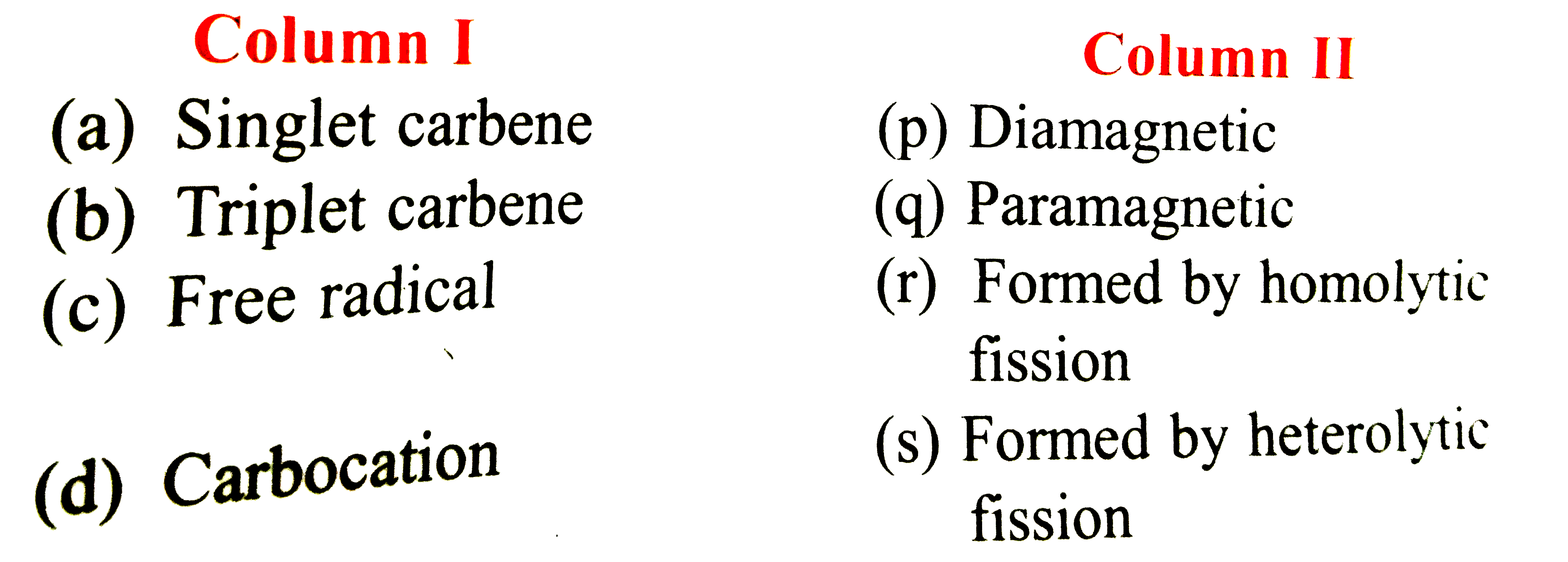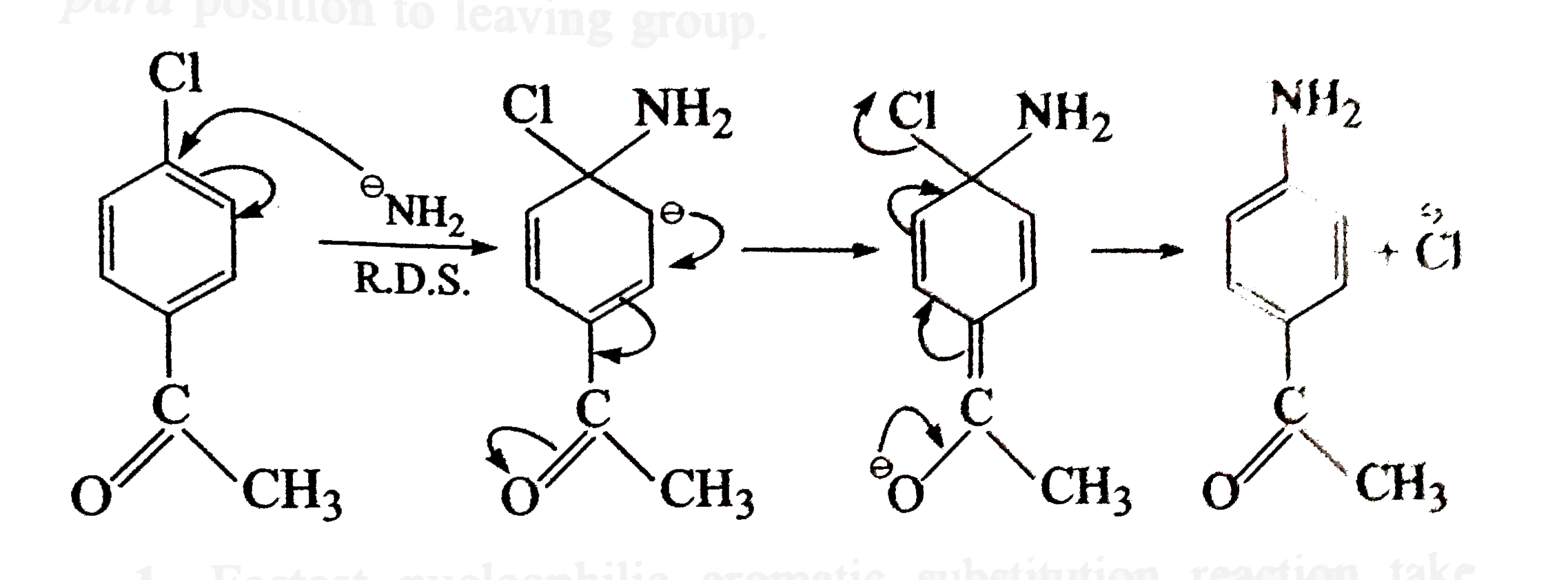Nuclephilic substitution reaction is given by those compounds which have nucleophilic groups as leaving groups. The weaker the basicity of a group of the substrate, the better is its leaving ability.
In nucleophilic substitution reactions, the basicity of leaving group should be less than the incoming nucleophilic group. Nucleophilc substitution reaction at sp3 -hybridised carbon is either bimolecular (SN2) or unimolecular (SN1). Bimolecular reaction takes place in single step, involving transition state intermediate. In SN2 reaction is preferred if the compound has less steric hindrance.
Unimolecular (SN2) reaction involves two steps and carbonium ion intermediate. Optically active substrates give recemic mixture in these reactions.
Select the correct statements among the following:
carbocation rearrangement takes place in SN1 reaction
SN2 mechanism is favoured when nucleophile is neutral
SN1 mechanism is favoured when nucleophile is neutral
tertiary alkyl halides give only SN1 reaction
Step by step video & image solution for Nuclephilic substitution reaction is given by those compounds which have nucleophilic groups as leaving groups. The weaker the basicity of a group of the substrate, the better is its leaving ability. In nucleophilic substitution reactions, the basicity of leaving group should be less than the incoming nucleophilic group. Nucleophilc substitution reaction at sp^(3) -hybridised carbon is either bimolecular (S_(N^(2))) or unimolecular (S_(N^(1))). Bimolecular reaction takes place in single step, involving transition state intermediate. In S_(N^(2)) reaction is preferred if the compound has less steric hindrance. Unimolecular (S_(N^(2))) reaction involves two steps and carbonium ion intermediate. Optically active substrates give recemic mixture in these reactions. Select the correct statements among the following: by Chemistry experts to help you in doubts & scoring excellent marks in Class 12 exams.
Updated on:21/07/2023Topper's Solved these Questions
- BASIC PRINCIPLES OF ORGANIC COMPOUNDS (MECHANISM OF ORGANIC REACTIONS)Book:OP TANDONChapter:BASIC PRINCIPLES OF ORGANIC COMPOUNDS (MECHANISM OF ORGANIC REACTIONS)Exercise:PASSAGE-II
Explore 5 Videos
- BASIC PRINCIPLES OF ORGANIC COMPOUNDS (MECHANISM OF ORGANIC REACTIONS)Book:OP TANDONChapter:BASIC PRINCIPLES OF ORGANIC COMPOUNDS (MECHANISM OF ORGANIC REACTIONS)Exercise:PASSAGE-III
Explore 5 Videos
- BASIC PRINCIPLES OF ORGANIC COMPOUNDS (MECHANISM OF ORGANIC REACTIONS)Book:OP TANDONChapter:BASIC PRINCIPLES OF ORGANIC COMPOUNDS (MECHANISM OF ORGANIC REACTIONS)Exercise:MATRIX-MATCH TYPE QUESTIONS
Explore 1 Video
- BASIC PRINCIPLESBook:OP TANDONChapter:BASIC PRINCIPLESExercise:SECTION V INTEGER ANSWER TYPE QUESTION
Explore 3 Videos
- CARBOXYLIC ACIDS AND THEIR DERIVATIVESBook:OP TANDONChapter:CARBOXYLIC ACIDS AND THEIR DERIVATIVESExercise:Integer
Explore 4 Videos
Similar Questions
Alkylation of aromatic compounds with aliphatic compounds like halides in presence of Lewis acid catalyst is known as Friedel-Crafts alkylation. It is an exapmle of electrophilic substitution.

In the process of acylation, R−O∣∣C− group is introduced to the ring. Compounds having (+ mesomeric groups) like −NH2 do not give Friedel-Crafts reaction because these compounds undergo conjugation with the catalyst. In the alkylation process, most branched alkyl group is substituted because isomerisation of carbonium ion takes place. In some Friedel-Crafts reactions, the nature of product changes with the solvent used in the reaction.
Predict whether the following statements are ture or false:
AlCl3 (aq.) is used as catalst in Frieded-Crafts reaction:
(a) True (b) False
View SolutionHyperconjugation describes the orbital interactions between the π-system and the adjacent σ-bond of the substituent group(s) in organic compounds. Hyperconjugation is called as Baker and Nathan effect. The necessary and sufficient conditions for the hyperconjugation are:
(i) Compound should have at least one sp2-hybrid carbon of either alkene, carbocation or alkyl free radical.
(ii) α-carbon with respect to sp2 -hybrid carbon should have at least one hydrogen.
Hyperconjugation are of three types:
(i) σ(C−H),π-conjugation,
(ii) σ(C−H), positive charge conjugation,
(iii) σ(C−H), odd electron conjugation.
The hyperconjugation may be represented as,


Number of resonating structures due to hyperconjugation =(n+1), where n is the numebr of α-hydrogen. Greater is the number of such forms, more is the stability of the species under consideration.
Hyperconjugation is possible in which of the following species?
View SolutionMatch the following :

View SolutionIn the Avogadro's number 6.023×1023 the number of significant figures will be:
View SolutionHow many different condensation products would be form by the given reaction?
CH3−O∣∣C−OC2H5+CH2−O∣∣C−OC2H5C2H5−O+Na−−−−−−→C2H5OH
View SolutionFor a typical nucleophilic aromatic substitution reaction to take place .
1. Nucleophilic atom should be of oxygen nitrogen or sulphur.
2. Leaving groups should be halide.
3. There should be strong electron withdrawing at ortho and para position to leaving group.

Fastest nucleophilic aromatic substitution reaction take place in :
View SolutionNuclephilic substitution reaction is given by those compounds which have nucleophilic groups as leaving groups. The weaker the basicity of a group of the substrate, the better is its leaving ability.
In nucleophilic substitution reactions, the basicity of leaving group should be less than the incoming nucleophilic group. Nucleophilc substitution reaction at sp3 -hybridised carbon is either bimolecular (SN2) or unimolecular (SN1). Bimolecular reaction takes place in single step, involving transition state intermediate. In SN2 reaction is preferred if the compound has less steric hindrance.
Unimolecular (SN2) reaction involves two steps and carbonium ion intermediate. Optically active substrates give recemic mixture in these reactions.
Which compound will give Walden inversion in SN2 reaction?
View SolutionNuclephilic substitution reaction is given by those compounds which have nucleophilic groups as leaving groups. The weaker the basicity of a group of the substrate, the better is its leaving ability. In nucleophilic substitution reactions, the basicity of leaving group should be less than the incoming nucleophilic group. Nucleophilc substitution reaction at sp^(3) -hybridised carbon is either bimolecular (S_(N^(2))) or unimolecular (S_(N^(1))) . Bimolecular reaction takes place in single step, involving transition state intermediate. In S_(N^(2)) reaction is preferred if the compound has less steric hindrance. Unimolecular (S_(N^(2))) reaction involves two steps and carbonium ion intermediate. Optically active substrates give recemic mixture in these reactions. Which among the following will give S_(N^(1)) reaction?
View SolutionNuclephilic substitution reaction is given by those compounds which have nucleophilic groups as leaving groups. The weaker the basicity of a group of the substrate, the better is its leaving ability.
In nucleophilic substitution reactions, the basicity of leaving group should be less than the incoming nucleophilic group. Nucleophilc substitution reaction at sp3 -hybridised carbon is either bimolecular (SN2) or unimolecular (SN1). Bimolecular reaction takes place in single step, involving transition state intermediate. In SN2 reaction is preferred if the compound has less steric hindrance.
Unimolecular (SN2) reaction involves two steps and carbonium ion intermediate. Optically active substrates give recemic mixture in these reactions.
Which among the following will give enantiomeric pair on treatment with HOH?
View SolutionNuclephilic substitution reaction is given by those compounds which have nucleophilic groups as leaving groups. The weaker the basicity of a group of the substrate, the better is its leaving ability. In nucleophilic substitution reactions, the basicity of leaving group should be less than the incoming nucleophilic group. Nucleophilc substitution reaction at sp^(3) -hybridised carbon is either bimolecular (S_(N^(2))) or unimolecular (S_(N^(1))) . Bimolecular reaction takes place in single step, involving transition state intermediate. In S_(N^(2)) reaction is preferred if the compound has less steric hindrance. Unimolecular (S_(N^(2))) reaction involves two steps and carbonium ion intermediate. Optically active substrates give recemic mixture in these reactions. S_(N^(2)) reaction involves transition state intermediate, hence it is favoured in which of the following solvents?
View SolutionThe correct order of leaving group ability in a nucleophilic substitution reaction is
View SolutionIn nucleophilic substitution reaction, the order of halogens as leaving group should be :
View SolutionWhich is the best leaving group in a nucleophilic substitution reaction?
View SolutionNucelophilic aliphatic substitution reaction is given by those compounds which have nucleophiic groups as leaving. Less is the basicity of the leaving group. More is its leaving power. Leaving group in the form of nucleophile (charged of neutral) Leaving power of which grops is maximum ? Leaving power of which group is maximum ?
View SolutionNucelophilic aliphatic substitution reaction is given by those compounds which have nucleophiic groups as leaving. Less is the basicity of the leaving group. More is its leaving power. Leaving group in the form of nucleophile (charged of neutral) Leaving power of which grops is maximum ? Leaving power of which group is maximum ?
View Solution